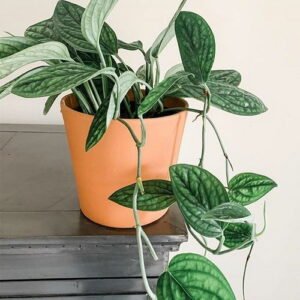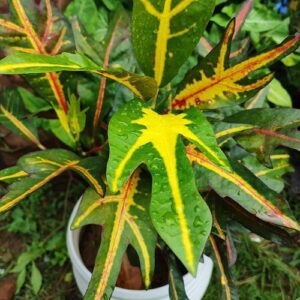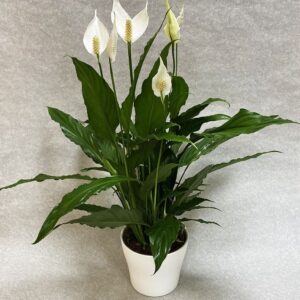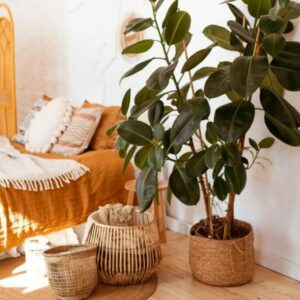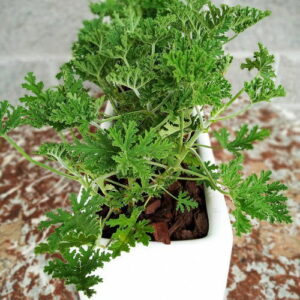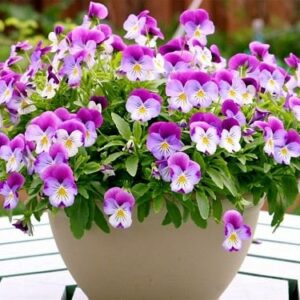Potted plants make the home more cozy and colorful and provide good air. We show you the best indoor plants for your home.

Greenery and flowers are not limited to the outdoors; plants are also welcome indoor residents. They not only make the apartment cozier, but they are also super decorative and provide a good indoor climate. But not all plants can easily be kept indoors – some plants need a lot of attention and skill to thrive indoors.
Fortunately, there is also the opposite: plants that grow almost by themselves, even indoors. Here you can learn which specimens are the best indoor plants and how to care for them.
1. Kentia palm
Kentia palm (Howea forsteriana) is an impressive houseplant that impresses with its simple elegance. With its beautiful feathery leaves and uniformly dense growth, the kentia palm fits into almost any room and provides the right feel-good factor there. If cared for well, this slow-growing houseplant can reach an impressive height of three meters. But fortunately the palm is very hardy: its only dislike is direct sunlight. On the contrary, it is enough to water it only once a week. However, to ensure that the kentia palm stays looking good for a long time, you should wipe away dust from time to time. Otherwise, an ugly layer forms quickly, especially on the large leaves.

2. Dragon tree
A classic indoor plant is also the dragon tree (Dracaena). And rightly so: not only is the dragon tree a wonderfully decorative houseplant even as a specimen, it even improves the indoor climate as well. In this way, the air-purifying plant filters harmful formaldehyde from its environment, ensuring relaxed breathing. But this is not the only reason for its extraordinary popularity as a houseplant – in addition to everything else, the care of the evergreen dragon tree is not difficult at all. In a bright to semi-shady location without direct sunlight, the houseplant only needs regular watering. You should make sure that the substrate has dried before the next watering because the tree cannot tolerate water sickness. However, high humidity is not a problem for the dragon tree, which is why it is wonderful for the bathroom.

3. Snake plant
snake plant (Sansevieria) is known as a houseplant mainly because of its low maintenance requirements. In fact, the plant forgives almost all care errors, which makes it suitable even for beginners and people without green fingers. Just two things you should pay attention to when taking care of the snake plant: First, the plants should only be watered when the soil in the pot is completely dry (this is about every two weeks). Secondly, it should be given the warmest possible place – the snake plant feels comfortable in temperatures of 15 °C and above. But the snake plant has more than its simple needs suggest: its upright growing, sword-shaped leaves with a golden yellow pattern make it a simple but stylish indoor plant that perfectly complements any space.

4. Peace lily
Noble, useful and also easy to care for? The Peace Lily (Spathiphyllum) has all three properties. In addition to its classic elegance, which it derives from its white flowers that contrast with the glossy green of the leaves, the peace lily is also known as an air purifying plant. Scientific studies have been able to prove that the peace lily can absorb and break down harmful gases and thus provide a favorable indoor climate. And this useful beauty is anything but a diva: if you avoid drafts and water sickness and ensure temperatures around 20 to 25 °C, the peace lily feels completely at home.

5. Philodendron
Philodendron proves to be an extremely attractive green plant with its heart-shaped, finely drawn leaves. When grown as a climbing plant on a planter pole, the plant adds an exotic flair, but it also shows its best side as a hanging basket plant and quickly provides a stunning foliage curtain. But as a plant for indoor use, philodendron is popular not only because of its beautiful appearance. Its low maintenance also makes it a great houseplant: for example, philodendrons require little, but offer a lot. Only regular watering philodendron should, in addition, the room temperature should never fall below 12 °C.

6. ZZ facility
Especially in dark rooms, many plants grow sickly or even start to care – not so the ZZ plant (Zamioculcas zamiifolia): even in shady rooms this plant continues to grow undisturbed. Especially its robust nature makes the plant an ideal roommate. A normal room temperature, no direct sun and a regular sip of water is enough for the plant’s happiness. The extremely hardy and thrifty plant with its leathery, dark green leaves is also a visual asset to any home. At the same time, with a height of up to one meter, it is also perfectly suited as a solitary, enriching any room with its charm.

Tip: You can find more plants for dark rooms in our dedicated article.
7. Parlor palm
Parlor’s Palm (Chamaedorea elegans) comes from the mountains, to be more precise from the mountain forests of Mexico. Indoors, the palm with its elegant, overhanging leaves gives a touch of sun, beach and sea. But if you think you have to put in a lot of effort to get that holiday feeling, you’re wrong. Only about every two weeks should the plant’s root ball be watered in a full bath, so that the roots can soak. Also, placed in a light to semi-shady location without direct midday sun, the parlor palm usually thrives on its own.

8. Devil’s ivy
Whether a hanging basket, climber or specimen plant, devil’s ivy (Epipremnum aureum) always cuts a nice figure. Their leaf shape is reminiscent of philodendron leaves, which is not surprising, after all, both plants are closely related. In addition, however, devil’s ivy is characterized by unusual leaf coloring and patterning, which can vary from dark green to yellow to white. Devil’s ivy does particularly well in light to semi-shady locations, but it can also tolerate shady spots – only its patterns won’t develop as colorfully here. In addition, the plant should be watered regularly. If these points are observed, devil’s ivy will thrive and form fantastically long shoots.

9. Chives
With almost 2000 known varieties, chives (Sempervivum) should have something for everyone. In this regard, leeks shine with their almost incredible diversity, which is reflected in the color, shape and size of the plants. Thus, depending on the variety, the beautiful rosette-like foliage not only has a different structure, but can also be colored in green, red or blue-grey. Also, the flowers can look pink, red or even yellow and white – with leeks you can choose almost endless varieties. But especially its hardy nature makes the leek a fantastic plant for indoor use. Thus, the leek only needs to be watered once a week, the plant does without fertilizer. The tenacious succulent is even forgiving of gross care mistakes. This may have given it its botanical name “sempervivum”, meaning “always alive”, among other things.

10. Violin leaf fig
Don’t you want a small, inconspicuous houseplant without a real eye-catcher? Then the fiddle leaf fig (Ficus lyrata) is just the thing for you: with its large, impressive leaves, which are also strikingly veined, the fig attracts all eyes. But if you think that such an impressive plant also needs a lot of care, you are wrong. In fact, the fiddle leaf fig is one of the easier houseplants to care for. For good growth it only needs temperatures above 16 °C, should be watered occasionally and given some fertilizer about every 14 days – only water sickness should be avoided at all costs. If the violet leaf ficus grows over your head if you take too good care of it, you may even reach for the scissors as the plant tolerates pruning very well. However, wear gloves when doing so: the sap that oozes out can cause skin irritation.

Tip: Potted plants should also be sufficiently fertilized, in the pot the nutrients are often used up quickly. A liquid fertilizer like our Plantura Liquid Houseplant Food is perfectly adapted to the needs of indoor plants and is administered quickly and easily through the irrigation water.
